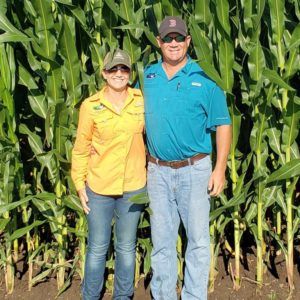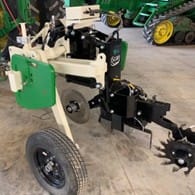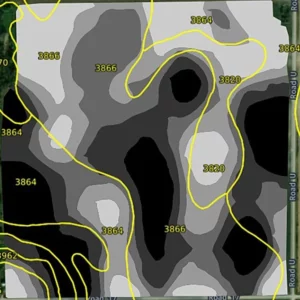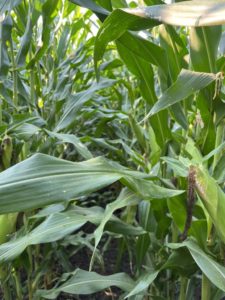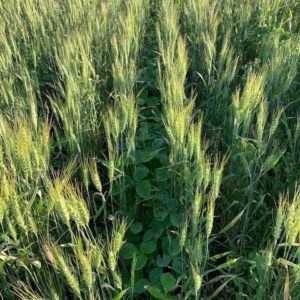Soil Health Strategies for Producing Higher Quality Crops
Amy Bruch is a sixth-generation farmer and president of Cyclone Farms in York, Nebraska. In 2021, she was recognized as the Organic Farmer of the Year by the Organic Trade Association and is the current chair of the National Organic Standards Board.
She started her farming career working to build and balance poor soils in Brazil. Amy and her husband moved back to the family farm in 2012, when her father passed away, and began transitioning their 2,500 irrigated acres to organic in 2017.
Their rotations hinge on the ability to build soil while also balancing the need to find viable markets and secure crop insurance for the chosen rotational crops. They primarily grow food-grade white and yellow corn, blue corn, seed corn, hard red winter wheat, yellow field peas, oats, alfalfa, canola, sunflowers and food-grade soybeans.
Intentional Soil Balancing is the Key
Amy uses a variety of tools to get the data she needs to implement a soil health plan. In 2016, Cyclone Farms rented a Veris electrical conductivity mapping machine to analyze each acre and get an in-depth view of the soil.
This machine measures the electrical conductivity of soil by sending an electrical current two feet into the rooting zone. The current responds to the amount of salt in soil, as well as the composition of the soil and can reveal the ratios of sand, clay, organic matter and water in the soil.
The mapping machine is pulled behind a tractor with a global positioning system receiver to record the location of each measurement point in the field. This information helps inform management decisions for different parts of the field. Veris analyzed the raw data and made soil maps for the farm. Zone mapping allows Amy to cost-effectively manage each zone differently depending on what it needs annually.
Amy collects plant tissue samples throughout the season and layers this information over the soil zone maps to build a total systems approach. They use the Kinsey-Albrecht system and start by balancing the calcium and magnesium ratios.
After this is achieved, they move on to balancing the macronutrients, micronutrients and trace elements. Then, they look at the physical structure of the soil and identify areas of compaction. Finally, they examine the biological aspects of the soil.
Amy looks at the data she has gathered and does a root cause analysis to find out why a problem or deficiency exists. She then creates a plan to address and correct the issue.
Cyclone Farms has intentionally invested in equipment with matching widths, leading to controlled traffic patterns in the field, to reduce soil compaction. Maintaining the physical structure of the soil is important for growing healthy plants. They also use real-time kinematic positioning, a precise positioning technique that uses a GPS to keep machinery on the same path, which also limits areas of compaction.
It’s important to know what your soil deficiencies are and where they occur. These deficiencies can be the first cause of yield loss. Identifying the limiting factors in your soil is the first step in creating a plan to restore plant health and reduce reliance on off-farm inputs through precision solutions.
Nitrogen Management
Many organic farms use manure as a nitrogen source. Selecting the right type is important because nitrogen content varies among sources. Storage and delivery methods also impact effectiveness. Solid manures will release nitrogen slower than their liquid counterparts.
Hog manure has 70 to 100 percent nitrogen availability. It is mainly in the inorganic form of ammonium nitrogen which dissolves and is readily available to plants.
Poultry litter has nitrogen availability over multiple years. In the first year, 40 to 60 percent of the nitrogen is available. In the second year, it goes down to 10 to 30 percent available. The nitrogen is mainly in its organic form, which requires decomposition by microorganisms in the soil before plants can access it.
Cyclone Farms applies chicken litter in split applications. Amy says they do this to save money by seeing how winter is going to impact their small grains crop. If there is winter kill, they save by applying less nitrogen.
Nutrients can build up in the soil when using manure or litter. If nitrogen is the only nutrient the soil needs, monitoring is important to keep the other elements balanced. Balancing soils after having a build-up of phosphorus, potassium and calcium can be difficult and takes different crop rotations and management techniques to rebalance.
Cover Crops
Amy says cover crops are “really important from a strategic deployment standpoint.” They can be used as a management tool to address specific problems. For example, rye can help with weed control; legumes such as clover, vetch and pea varieties can help with nitrogen delivery; radishes, turnips and rye can help with compaction; and mustard can reduce disease pressure in subsequent crops.
Choosing the right cover crop and planting it in the right spot is critical. For example, vetch is vulnerable to freezing and can die without snow cover. Vetch benefits from being planted with oats. When the oats die, they create a blanket over the vetch and protect it from the cold. This is one example of how combining different cover crops can maximize soil health benefits.
Scouting for Weed and Disease Prevention
Scouting is important for disease prevention and mitigation. Research and scout at the right times for each crop. Weather affects timing and informs what to scout for and how often. If it is cold and rainy, scout more frequently to help mitigate disease pressure that might increase later in the growing season.
Managing weeds in an organic system is important to keep weed seed banks from building up. Scouting also allows you to prevent weeds from hosting insects, spreading disease and competing for fertility and water in the soil.
Cyclone Farms follows the Kinsey-Albrecht approach to soil fertility. This method focuses on soil health, based on the idea that when you feed the soil, the soil will feed the plant.
Focusing on soil health means actively balancing and building the soil. Some products are going to feed the soil but not build it. Applying these products might help for that growing season, but then it becomes an annual application. This method works against the goal of building soil health.
Amy says the Kinsey-Albrecht approach gives her a checklist to identify the root cause of issues in the field. It also helps her break the cycle of applying products that feed the plants but don’t build soil health.
This method moves the focus beyond N-P-K. The Kinsey-Albrecht approach looks holistically at soil health by identifying limiting factors of the soil and addresses the physical, chemical and biological means to build the soil and reduce crop stress.
Amy has used this method to improve poor soil and create a more balanced, healthy and fertile soil that grows quality crops. She says it helps her create a tangible road map to an end goal, and that she has seen an improvement in soil health over time.
How to Start a Soil Health Journey
Collect information on your soil and identify your end goals to start your soil health journey. When transitioning to organic, it is important to list what equipment and labor you have access to, know what crops have a market and know which crops qualify for insurance when putting together a comprehensive plan.
Lay out this information and use it to make a customized plan. Build your crop rotations based on balancing the soil and market availability. Balancing soil and building its health may take two or three years before you start to see results.

